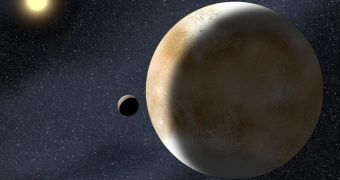A team of astronomers led by Stephen Tegler from the Northern Arizona University in Flagstaff were culling through pictures of the biggest dwarf planet beyond Neptune called Eris, when they came across a startling discovery. The small plutoid (as this type of planets is named) sported major changes in its surface composition, as indicated by some pictures taken at different points in time, separated by a two-year period.
The first set of spectroscopic imagery was captured in 2005 thanks to the 4.2 meter William Herschel Telescope located in Spain, while the second was obtained in 2007, by means of the Arizona-based 6.5 meter MMT observatory. The analysis based on the photos suggests a rapid and major alteration in the concentration of frozen nitrogen on Eris.
At the moment, the plutoid is situated at its orbital point farthest from the Sun (called aphelion), about 100 Astronomical Units (AU – multiples of the distance between the Earth and the Sun) far from our system's star. Considering that it takes 557 years for Eris to complete a full orbit cycle, it is easy to conclude that the influence of the Sun has not changed during the recent several years, which rules out the possibility that this phenomenon is somewhat linked to the Sun's activity or influence on the plutoid.
There is the possibility, though, that the two series of photographs captured different faces of Eris (which has a rotation period of 26 hours), which may not be similar to one another – hence the lack of consistency of the spotted event. In 2005, it seems there was a higher concentration of nitrogen near the surface, while two years later, the higher concentration was below the surface, hinting to the existence of a dynamic process as one of the only reasonable causes for the differences on such a tiny planet.
The only other explanation found so far involves cryovolcanism, meaning that, if Eris was sufficiently warm, volcanoes would eject volatile mater (such as nitrogen and methane) which would condense into a solid form, therefore altering the planet's composition. As further observations of Eris will come up with more results, we'll keep you posted.

 14 DAY TRIAL //
14 DAY TRIAL //